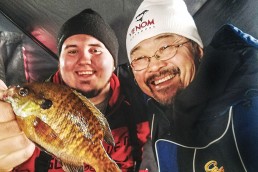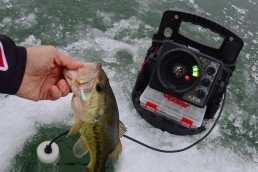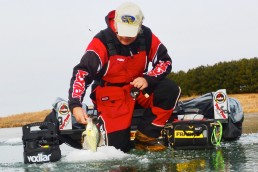Get Some Glow Jigs for Ice Fishing
SHARE THIS POST
A bright idea for hard water: try glow colors for low-light conditions. Fishing at night, in low-light at sunrise and sundown or in stained or dirty water creates special challenges for ice anglers. Fish can’t eat a bait that they can’t see.
High-glow colors can fire up a jig. Walleyes and other species that depend largely on sight to eat can find some of these unique and new glow colors even in the most difficult situations.
Different colors emit light at different intensities under different conditions. One color may overpower fish. Another color may not be enough to draw them near. Experiment and let the fish tell you what they want.
Bright even in the day
Glow jigs shine even in daytime and will catch walleyes and panfish when nothing else works. Why? Maybe it’s because you’re fishing at sunrise or sunset. Many lakes in the upper north are fed by streams that flow through cedar swamps. Water is stained like tea by tannic acid. Visibility is diminished even at midday.
When that’s the case, fish go deeper when winter arrives. They are forced out of the shallows when weeds die and sap oxygen from their surroundings.
Baitfish often suspend in stained water, looking for the depth where plankton reside. Predators have a harder time finding them. A glow jig will attract them and the action that you impart on your jig makes them bite.
Stained and structured
Stained lakes normally offer classic structure situations. For walleyes, you usually can’t go wrong fishing over hard bottoms on the steepest drops to the deepest part of the lake. Use a LakeMaster GPS map to search out potential spots. Drill multiple holes and use a portable depth finder to search for fish.
Later in winter, move to deeper structure, like midlake humps. As ice-out nears, concentrate on spots near spawning areas.
Jig aggressively with minnows for walleyes to prompt a reaction bite from the most active ones. Hook the minnow through the mouth and up through the head.
Small lakes may host spectacular prospects for panfish like bluegills, crappies and perch. Go to the deepest area of the lake, remembering that “deep” is relative. On large lakes, look for deep areas in bays and inside turns on points at the mouths of bays that reach to deep water.
High-performance presentations
Smaller, vertical-hanging jigs, combined with eurolarvae, work best for panfish. Use a sensitive ice stick like St. Croix’s Avid Glass rods that let you keep in touch with your bait. Jiggle it constantly with short movements so the jig vibrates. The action helps you feel the lure better. It also keeps the bait from spinning too much.
Are you enjoying this post?
You can be among the first to get the latest info on where to go, what to use and how to use it!
Perch tend to hold deeper in schools as big as a football field. When fishing with friends, leap-frog to drill holes at 100-foot intervals until someone connects.
Start with a red glow tungsten jig. Drop it to the bottom, slightly raise it and twitch. Fish may be finicky during the day. Try to stay away from the crowds of anglers.
The bite lights up after night
Action improves after dark for walleyes and some species of panfish, like crappies, that depend on their sight advantage. Even larger bluegills will bite after the sun goes down. Glow jigs are a must at night.
As for location, the same spots you fish during daytime will hold walleyes and crappies after dark. Bottom structure that holds baitfish is best for walleyes. Focus on drop-offs near points, on humps or channel edges.
Crappies often suspend over the deepest water in small lakes. In larger lakes, they can be found suspended. Funnel areas between the tips of two points which come close to each other or where a sunken island is located just off a point are good, too. Fish are not so spooky after dark. Fish with friends or migrate toward the groups.
Other tips
Use the smallest auger you think you’ll need. The bigger the auger, the more ice you must drill and the more work you must do. The more work, the less mobile you will be.
If you don’t connect with any fish, don’t stay long. The more you move, the more likely you are to locate active schools. Take a friend with you in case you run into trouble. Don’t fish alone.
Take your flotation cushion out of your boat and tie several feet of rope to it. It can be a lifesaver if one of your group falls through thin ice.
Light up your life with glow jigs through the ice.
MWO
SHARE THIS POST
Did you enjoy this post?
You can be among the first to get the latest info on where to go, what to use and how to use it!
Scott Richardson
Scott Richardson is a retired outdoor editor for a Central Illinois newspaper and longtime writer for magazines, a writing partner with popular writer and walleye pro Ted Takasaki for more than 30 years and a member of the Illini Muskies Hall of Fame. He’s also written two books with Wisconsin fishing guide Greg Bohn on bobber fishing for walleyes.



